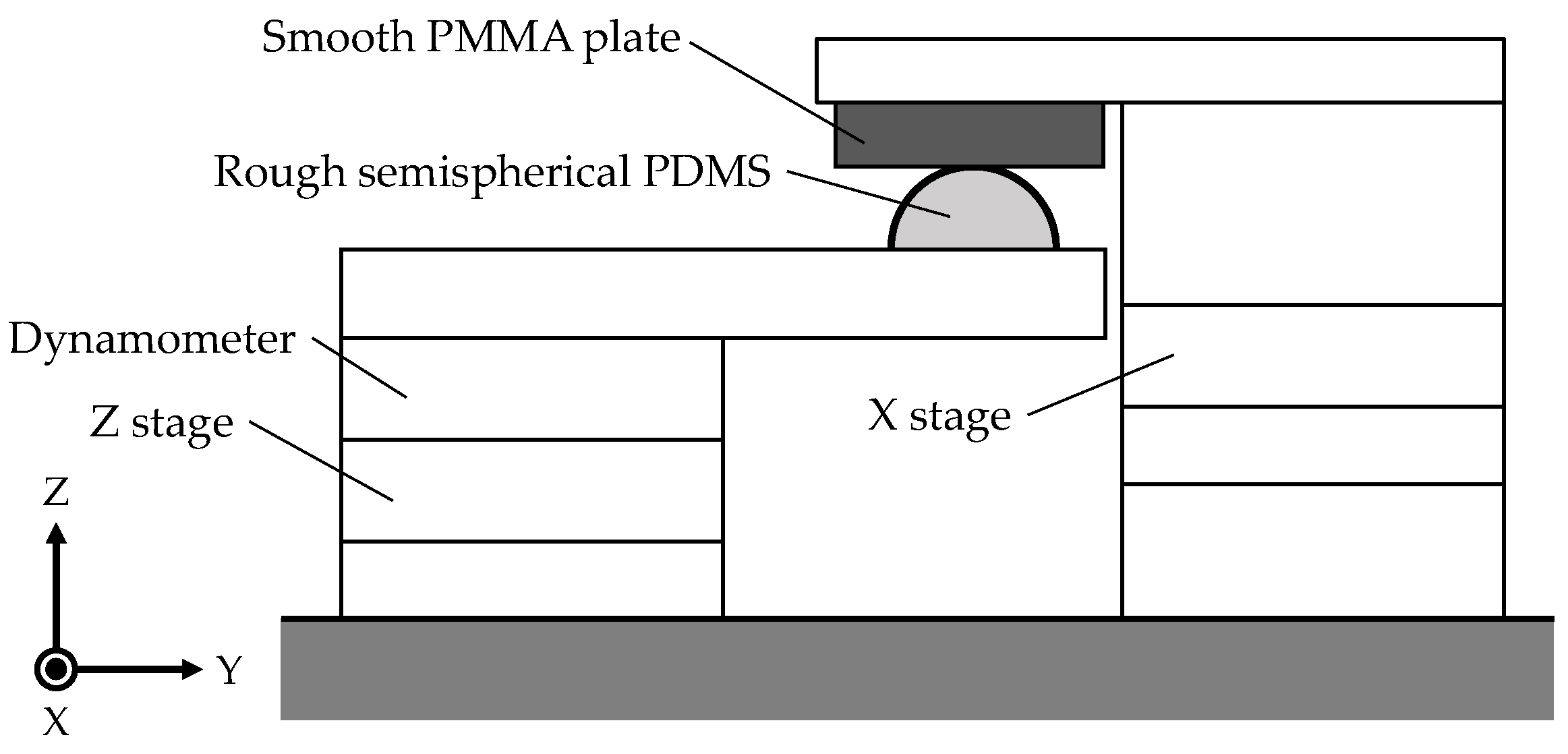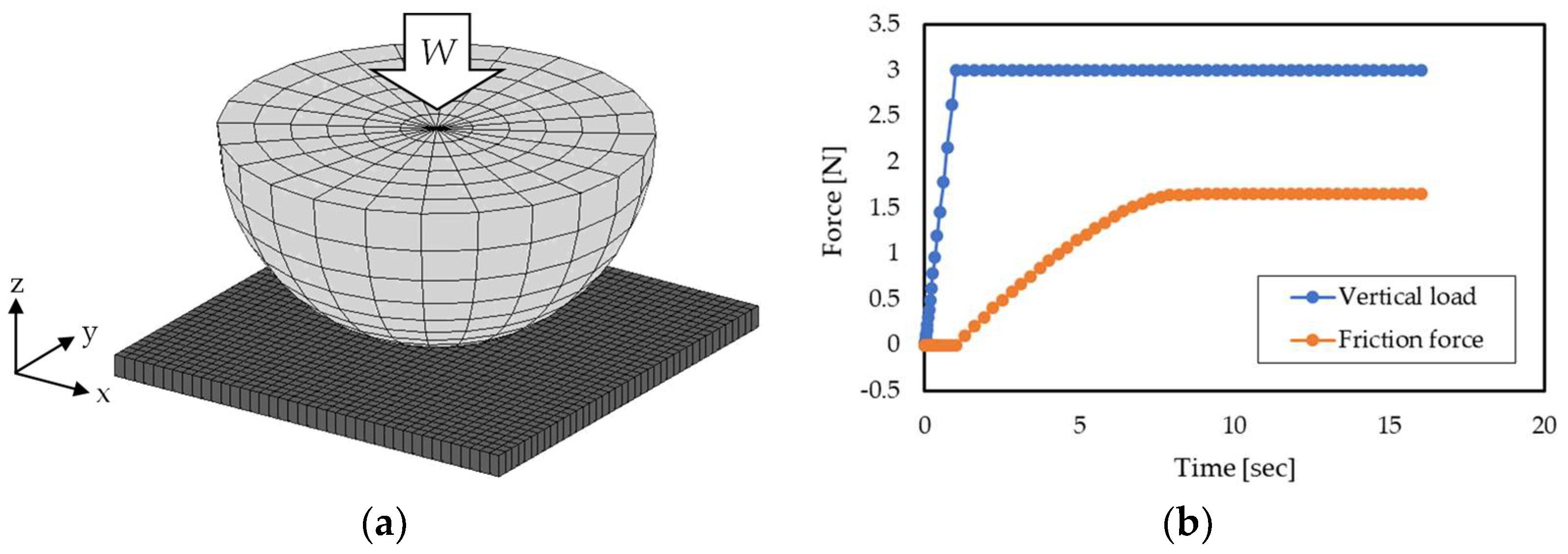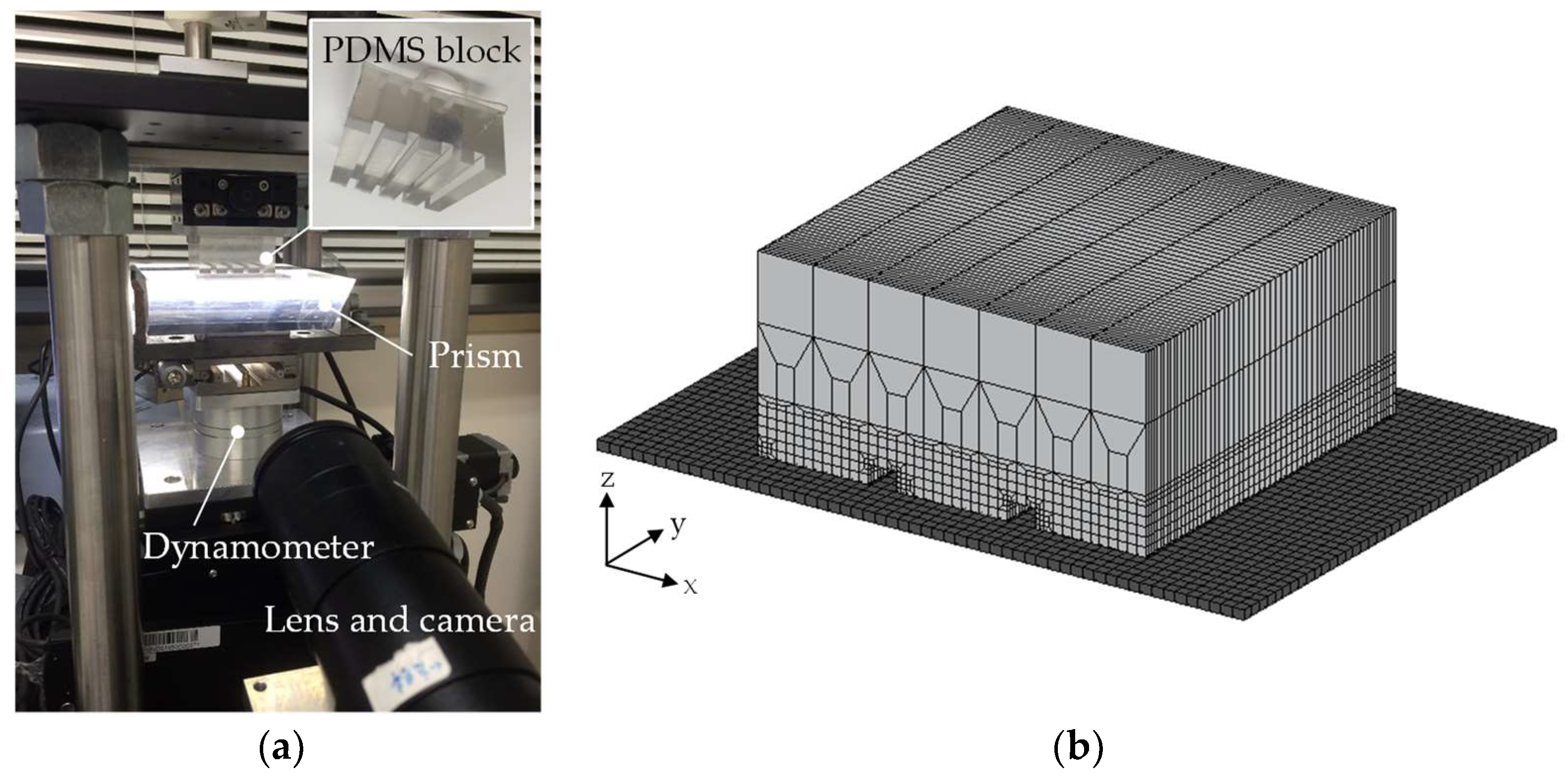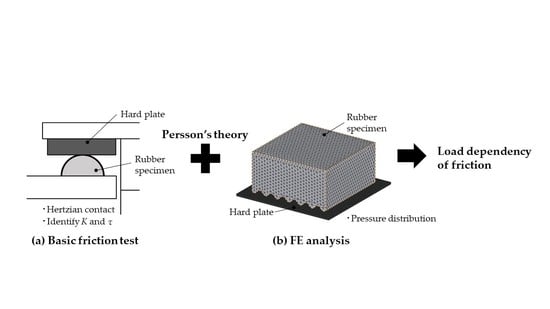1. Introduction
In general, friction
F between solids is described as the sum of a hysteresis term
and an adhesive term
, except for the effects of ploughing and lubrication [
1], i.e.,
Here,
is due to the energy dissipation during the deformation of solids [
2]. For instance, in the case of contact between a rubber specimen and a rough hard surface, such as contact between tire and asphalt, the hysteresis term becomes dominant [
3,
4].
Meanwhile,
originates from the intermolecular forces between solids [
5]. Roberts and Thomas [
5] and Persson and Volokitin [
6] reported that the adhesive friction becomes dominant when rough rubber slides on a smooth rigid plane. In this study, we focused on adhesive friction only. Thus, the following equation holds.
Adhesive friction can be evaluated by the real contact area
and the shear strength
as follows:
In the case of friction between metals, in general, the real contact area is proportional to the contact load
W. That is,
holds. The relation of
, which is widely known as the multi-asperity contact theory (Greenwood-Williamson theory), generally holds regardless of the asperity shape on the surface, contact form, etc. [
7,
8,
9]. Therefore, when the hysteresis term can be neglected, the following friction law of Amonton–Coulomb holds.
where
is the friction coefficient.
However, in the case of a soft material such as rubber/elastomer, since the fraction of the real contact area
to the apparent contact area
becomes relatively large when it is subjected to a high contact load, the proportional relationship of
is no longer maintained in that regime [
10,
11,
12,
13,
14]. As the contact load increases, the distance between the real contact points decreases, and the rate of increase of the real contact area is reduced by the mutual interference between the contact points, so
holds [
13,
14]. Therefore, as can be inferred from Equation (3), the friction force becomes constant, and the friction coefficient defined by Equation (4) decreases as the contact load (pressure) increases.
Several studies have been conducted on the transition process from a multi-asperity contact state in a low contact load regime to a full contact state in a high contact load regime [
10,
11,
12,
13,
14,
15]. In particular, one of the authors conducted a friction test between a hemispherical rubber specimen with several levels of surface roughness and a smooth acrylic plate to examine the contact load dependency of the real contact area [
15]. In addition, the real contact area was visualized using a reflecting optical system, and the relationship between contact pressure and the real contact area was investigated. Furthermore, Maegawa et al. [
15] focused on the fact that the contact pressure dependencies of the real contact area and the friction coefficient can be expressed using Persson’s contact theory [
4,
14] and proposed a method to estimate
and the shear strength
using only the results of friction test without visualization of the contact area. Therefore, if we can evaluate
and
under the prescribed contact load (strictly speaking, contact stress distribution at the contact area), the contact load dependency of the friction coefficient can be rationally evaluated at the same time. Note that the shear strength
depends only on the combination of materials and is not affected by the contact load or surface roughness.
However, the simplified estimation method proposed by Maegawa et al. [
15] is limited to the contact between a hemispherical rubber specimen and a flat hard plate. To utilize this method for the general design and development of rubber products, it is desirable to modify it to reflect the dependence of the contact pressure distribution variation on the dimensions of the sliding part and the geometric pattern of the surface.
In this study, we propose a method to predict the adhesive friction during perfect sliding between a rubber specimen with arbitrary surface roughness and surface pattern (geometric shape) by combining finite element (FE) analysis with the method proposed in [
15] in which the result of the basic friction test and Persson’s contact theory were utilized. We verified the validity of the proposed method through comparison with two types of experimental results, i.e., between a hemispherical rubber specimen and a flat plate and between a rubber block specimen with grooved surface and a flat plate.
3. Results and Discussion
To verify the proposed method, we predicted the friction coefficient for the contact between a hemispherical PDMS (poly-dimethyl siloxane) specimen and a PMMA (polymethyl methacrylate) flat plate, and for the contact between a PDMS block specimen with a grooved surface and a prism flat plate. For details of the molding process of PDMS, refer to Maegawa et al. [
15].
In this study, a commercial software package, MSC Marc, was used for FE analysis. We adopted a linear elastic body for the constitutive model of PDMS, while we assumed that the PMMA and prism are rigid bodies. The updated Lagrangian method was used for the treatment of geometric nonlinearity. Further, we adopted Amonton–Coulomb’s law based on the surface-to-surface contact discretization method.
3.1. Friction between Hemispherical Rubber and the Flat Plate
3.1.1. Basic Friction Test
First, assume that the friction test [
15] between the hemispherical PDMS rubber specimen with roughness and the smooth PMMA plate is targeted at predicting the friction coefficient.
Figure 2 shows the schematic view of the friction test for a hemispherical PDMS rubber specimen and PMMA plate contact, where the radius of the hemispherical PDMS is 9.5 mm. The friction test was conducted under constant sliding velocity and constant normal load.
In the friction test, one of the authors prepared three types of hemispherical rubber specimens with the same compounding ratio, then different rough surfaces were created using different emery papers for each PDMS specimen. The surface roughness of the specimens were Specimen I (
), Specimen II (
) and Specimen III (
). The Young’s modulus was determined through the JKR contact test [
17,
18] as
E = 1.2 MPa, whereas the Poisson’s ratio was set to
[
19]. In the friction test shown in
Figure 2, Hertz contact can be assumed; thus, we identified the parameters
K and
using Equation (9).
Table 1 presents the fitting results. Here, we assume that the shear strength
depends only on the combination of materials. Therefore, we identified the constant value
regardless of the surface roughness, whereas we identified three different values of
K for each specimen.
3.1.2. FE Analysis and Prediction of Adhesive Friction
This section focuses on the same problem as considered in the basic friction test, for the prediction of adhesive friction.
Figure 3 shows the FE analysis model and typical result of the contact forces. We adopted the eight-node solid element. To obtain a smooth contact pressure distribution, the contact part was discretized using fine elements. In the FE analysis, after applying a prescribed vertical load for the rigid shell element attached to the upper surface of the hemispherical PDMS, the rigid PMMA was allowed to move with a velocity of 0.1 mm/s in the
x-direction and slid for 15 s.
The friction coefficient itself is an input value in the FEM. However, it is considered that it does not exert a large influence on the pressure distribution if the magnitude of friction is within a certain range. To examine this point, we also carried out an analysis when the input value of the friction coefficient in FEM was set to 0.2, 0.4, 0.6, 0.8 and 1.0 for this prediction.
Figure 4 shows the contact load dependency of the friction coefficient predicted from the pressure distribution obtained by FE analysis and the already obtained
K and
. As can be observed in the figure, the predicted results and the test results are in good agreement. That is, it is possible to express the decrease of the friction coefficient as the load increases. In addition, we can predict the effect of the surface roughness on the contact load dependency of the friction coefficient. Furthermore, it can be confirmed that almost the same friction coefficient can be predicted regardless of the input value of the friction coefficient
in the FEM. The effect of the friction coefficient
on the contact pressure distribution obtained by FE analysis is small. Hence, it is considered that adhesive friction can be, to a certain extent, predicted by the proposed method in FE analysis by setting a practical value of
.
To examine the quality and the influence of fitting parameters
K and
, we conducted the sensitivity analysis, as shown in
Figure 5. In the analysis, we set eight values of
K and six values of
referring to the fitting results shown in
Table 1. The shear strength
affects the magnitude of friction force, while the parameter
K affects the gradient with respect to the load dependency of the friction force. From the results in
Figure 4 and
Figure 5, it is thought that the present fitting method and significant figures are reasonable. However, note that further investigation is necessary for the validity of
K and its identification method.
3.2. Friction between the Rubber Block with a Grooved Surface and the Flat Plate
3.2.1. Basic Friction Test
Next, for the case with geometric patterns on the contact surface, we attempted to predict the adhesive friction between the rubber block specimen with a grooved surface and the flat plate. The materials for the rubber block specimen and the flat plate are PDMS and prism, respectively.
To identify the parameters
K and
, we molded the hemispherical PDMS, which has the same compounding ratio as the PDMS block, and then, each surface roughness was controlled at the same value using the emery paper. Then, we conducted the basic friction test using the apparatus shown in
Figure 2, while the radius of the hemispherical PDMS specimen was 18 mm. Similarly, as presented in
Section 3.1, we determined the Young’s modulus based on the JKR contact test [
17,
18] as
E = 1.2 MPa, while the Poisson’s ratio was set to
[
19]. By comparing the results of the basic friction test between the hemispherical PDMS and prism plate for five levels of contact loads (0.45–6.69 N) with Equation (9), the parameters
K and
were identified as follows:
3.2.2. FE Analysis and Prediction of Adhesive Friction
Figure 6 shows the dimension of the PDMS blocks with a grooved surface, which are the targets for the prediction of adhesive friction. We prepared two types of specimens with a constant groove depth, but different pitch. Note that the surface roughness and compounding ratio were the same as those of the hemispherical PDMS specimen described in the basic friction test of
Section 3.2.1.
Figure 7a shows the measurement system of the friction between the PDMS block with a grooved surface and the prism plate. The surface of the prism is smooth enough compared to the PDMS block. In the measurement of adhesive friction, the prism plate was pushed from a lower side against the PDMS block fixed to the upper jig, and the prism plate was then driven horizontally while keeping a constant pressing displacement. The normal and tangential forces during sliding were measured using a dynamometer. We measured the friction coefficient between the PDMS block with a grooved surface and the prism plate for five levels of pressing displacement.
Figure 7b shows the FE model corresponding to the contact between the PDMS block with a grooved surface and the prism plate. Here, we adopted the eight-node solid element. To obtain a smooth contact pressure distribution, the contact part was discretized using fine elements. In the FE analysis, the boundary condition corresponding to the measurement method was set. That is, after applying the prescribed vertical displacement to the rigid shell elements attached to the upper surface of the PDMS block with a grooved surface, the rigid prism was allowed to move with a horizontal sliding velocity of 1.0 mm/s in the
x-direction. The sliding period was set to 10 s. In addition, the friction coefficient in the FE analysis was set to
.
For the prediction of the friction coefficient, we adopted the distribution of the steady state value of the contact pressure.
Figure 8a shows an example of the visualized distributions of the real contact in the experiment. Here, the dark region corresponds to the dense part of the real contact area. Further,
Figure 8b shows an example of the contact pressure distributions obtained by FEM. These results were obtained using Specimen B at 0.8 mm of vertical displacement. It can be observed from the figure that there is a corresponding relationship between the real contact area obtained by experiment and the contact pressure distribution obtained by FE analysis.
Figure 9 shows the contact load dependency of the friction coefficient predicted from the pressure distribution obtained by FE analysis and the
K and
values identified using Equation (10). The figure also includes the experimental results. As can be observed from the figure, the prediction results and the experimental results are in good agreement, and it is possible to express the decrease of the friction coefficient as the contact load increases. Furthermore, when the surface pattern of the rubber block is changed, the change in the friction can be predicted, if the target rubber specimens have the same material property and surface roughness. However, there was no perfect agreement with the experimental results, and the accuracy of the prediction result deteriorated especially for Specimen B. This is because when the contact surface has a complicated pattern, it is necessary to obtain an accurate pressure distribution. Thus, in such cases, the contact surface should be discretized more precisely using finer meshes. In addition, for the constitutive model, we adopted a linear elastic body, which cannot adequately describe the rubber deformation; this is another reason for the reduced prediction accuracy of the proposed method.
4. Conclusions
In this study, we proposed a method to predict rubber adhesive friction for an arbitrary contact type by combining the basic friction test, Persson’s contact theory and FE analysis. We prepared two types of specimens and measured the friction. Thereafter, the friction coefficient obtained by the proposed method was quantitatively compared with experimental result. It was confirmed that the prediction accuracy of the contact load dependency of the friction coefficient using the proposed method is reasonably good. Note that it is necessary to set the friction coefficient to a practical value to a certain extent. In particular, further investigation is required when the rubber significantly deforms due to friction. Besides, to identify the unknown parameters K and in the proposed method, we can directly use the profile of the contact pressure distribution obtained using FE analysis instead of Equation (9) when the contact type of the basic friction test does not obey the Hertz contact.
Moreover, the prediction accuracy of the proposed method could be improved by adopting a sophisticated discretization of the contact surface and an advanced constitutive model such as the hyper-elastic body for rubber, in the FE analysis. Note that since we focused on the fully sliding stage of the contact surface, the proposed method cannot deal with problems such as the Mindlin slip, in which the sticking and slipping regions coexist.















